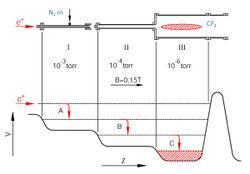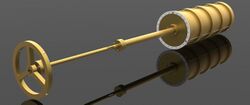Physics:Buffer-Gas Trap for Positrons
The buffer-gas trap (BGT) is a device used to accumulate positrons (the antiparticles of electrons) efficiently while minimizing positron loss due to annihilation. This annihilation occurs when an electron and positron collide, with the energy converted two or three gamma rays. The BGT is used for a variety of research applications, particularly those that benefit from specially tailored positron gases, plasmas and/or pulsed beams.

Design and Operation
The schematic design of a BGT,[1][2] is illustrated in Fig. 1. It consists of a specially designed (Penning- or Penning Malmberg-type) electromagnetic trap.[2] Positrons are confined in a vacuum inside an electrode structure consisting of a stack of hollow, cylindrical metal electrodes such as that shown in Fig. 2. A uniform axial magnetic field inhibits positron motion radially, and voltages imposed on end electrodes prevent axial loss. Such traps are renowned for their good confinement properties for particles (such as positrons) of a single sign of charge.[3]
Given a trap designed for good confinement, a remaining challenge is to efficiently fill the device. In the BGT, this is accomplished using a series of inelastic collisions with a molecular gas. In a positron-molecule collision, annihilation is much less probable than energy loss due to electronic or vibrational excitation. The BGT has a stepped potential well (Fig. 1) with regions at successively lower gas pressure. Electronic excitation of molecular nitrogen (N2) in the highest-pressure region is used to trap the positrons. This process is repeats until the particles are in a sufficiently low-pressure environment that the annihilation time is acceptably long. The particles cool to the ambient gas temperature due to inelastic vibrational and rotational collisions.
Trap efficiency is typically 5 – 30%, but can be as much as 40%.[4] Positronium formation via charge-exchange (e.g., e++ N2-> N2++ Ps) is a major loss process. Molecular nitrogen is used because it is unique in having an electronic energy level below the threshold for Ps formation; hence it is the trapping gas of choice.[5] Similarly, CF4 and SF6 have very large vibrational excitation cross sections, and so these gases are used for cooling to the ambient (typically ~ 300 K).[6]
While most positron sources produce positrons with energies ranging from a few kiloelectron volts to more than 500 keV, the BGT is only useful for much lower energy particles (e.g., ≤ tens of electron volts).[4] Thus, high-energy positrons from such sources are injected into the surfaces of materials (so-called positron moderators) in which they lose energy, diffuse to the surface, and are re-emitted with electron-volt energies.[4] The moderator of choice for the BGT is solid neon (~ 1% conversion efficiency [7]), frozen on a cold metal surface.
The lifetime in the final trapping stage is limited by annihilation and is typically ≤ 100 s, which limits the total number of trapped positrons. If larger particle numbers are desired, the positrons are transferred to an ultra-high vacuum (UHV) Penning-Malmberg trap in a several-tesla magnetic field. Annihilation is negligible in UHV. Positron cooling (necessary to combat heating due to extrinsic effects) is now due to the emission of cyclotron radiation in the large magnetic field.[4] This accumulation and transfer process can then be repeated to build up larger collections of antimatter.
History and Uses
The BGT was invented in the 1980s,[8] originally intended to study positron transport in tokamak (fusion) plasmas. Subsequently, the technique was refined and is now used in laboratories worldwide for a variety of applications. They include study of positron interactions with atoms and molecules, materials, and material surfaces;[9][10][11][12] the creation of antihydrogen,[13][14][15][16] the positronium molecule (i.e., Ps2, e+e−e+e−),[17] and novel positron[18] and Ps beams.[19] BGTs are also expected to play similarly important roles in efforts to create and study Ps-atom Bose-Einstein condensates (BEC)[20] and a classical electron-positron “pair” plasmas.[4][21][22]
See also
- Positron
- Penning trap
- Non-neutral plasmas
- Positron annihilation
- Positronium
- Antihydrogen
References
- ↑ Surko, C. M.; Passner, A.; Leventhal, M.; Wysocki, F. J. (17 October 1988). "Bound states of positrons and large molecules". Physical Review Letters (American Physical Society (APS)) 61 (16): 1831–1834. doi:10.1103/physrevlett.61.1831. ISSN 0031-9007. PMID 10038909.
- ↑ 2.0 2.1 Murphy, T. J.; Surko, C. M. (1 October 1992). "Positron trapping in an electrostatic well by inelastic collisions with nitrogen molecules". Physical Review A (American Physical Society (APS)) 46 (9): 5696–5705. doi:10.1103/physreva.46.5696. ISSN 1050-2947. PMID 9908819.
- ↑ Dubin, Daniel H. E.; O’Neil, T. M. (1 December 1998). "Trapped nonneutral plasmas, liquids, and crystals (the thermal equilibrium states)". Reviews of Modern Physics (American Physical Society (APS)) 71 (1): 87–172. doi:10.1103/revmodphys.71.87. ISSN 0034-6861. Bibcode: 1999RvMP...71...87D.
- ↑ 4.0 4.1 4.2 4.3 4.4 Danielson, J. R.; Dubin, D. H. E.; Greaves, R. G.; Surko, C. M. (17 March 2015). "Plasma and trap-based techniques for science with positrons". Reviews of Modern Physics (American Physical Society (APS)) 87 (1): 247–306. doi:10.1103/revmodphys.87.247. ISSN 0034-6861.
- ↑ Marler, J. P.; Surko, C. M. (21 December 2005). "Positron-impact ionization, positronium formation, and electronic excitation cross sections for diatomic molecules". Physical Review A (American Physical Society (APS)) 72 (6): 062713. doi:10.1103/physreva.72.062713. ISSN 1050-2947.
- ↑ Marler, J. P.; Surko, C. M. (8 December 2005). "Systematic comparison of positron- and electron-impact excitation of the ν3 vibrational mode of CF4". Physical Review A (American Physical Society (APS)) 72 (6): 062702. doi:10.1103/physreva.72.062702. ISSN 1050-2947.
- ↑ Mills, A. P.; Gullikson, E. M. (27 October 1986). "Solid neon moderator for producing slow positrons". Applied Physics Letters (AIP Publishing) 49 (17): 1121–1123. doi:10.1063/1.97441. ISSN 0003-6951.
- ↑ C. M. Surko, et al., The Positron Trap - a New Tool for Plasma Physics, in Positron Studies of Solids, Surfaces, and Atoms: A Symposium to Celebrate Stephan Berko's 60th Birthday, edited by J. A. P. Mills, W. S. Crane and K. F. Canter (World Scientific, 1984), p. 222-233.
- ↑ Schultz, Peter J.; Lynn, K. G. (1 June 1988). "Interaction of positron beams with surfaces, thin films, and interfaces". Reviews of Modern Physics (American Physical Society (APS)) 60 (3): 701–779. doi:10.1103/revmodphys.60.701. ISSN 0034-6861.
- ↑ Gidley, David W.; Peng, Hua-Gen; Vallery, Richard S. (2006). "Positron Annihilation as a Method to Characterize Porous Materials". Annual Review of Materials Research (Annual Reviews) 36 (1): 49–79. doi:10.1146/annurev.matsci.36.111904.135144. ISSN 1531-7331.
- ↑ Surko, C M; Gribakin, G F; Buckman, S J (9 March 2005). "Low-energy positron interactions with atoms and molecules". Journal of Physics B: Atomic, Molecular and Optical Physics (IOP Publishing) 38 (6): R57–R126. doi:10.1088/0953-4075/38/6/r01. ISSN 0953-4075.
- ↑ Gribakin, G. F.; Young, J. A.; Surko, C. M. (14 September 2010). "Positron-molecule interactions: Resonant attachment, annihilation, and bound states". Reviews of Modern Physics (American Physical Society (APS)) 82 (3): 2557–2607. doi:10.1103/revmodphys.82.2557. ISSN 0034-6861.
- ↑ Gabrielse, G.; Bowden, N. S.; Oxley, P.; Speck, A.; Storry, C. H.; Tan, J. N.; Wessels, M.; Grzonka, D. et al. (31 October 2002). "Background-Free Observation of Cold Antihydrogen with Field-Ionization Analysis of Its States". Physical Review Letters (American Physical Society (APS)) 89 (21): 213401. doi:10.1103/physrevlett.89.213401. ISSN 0031-9007. PMID 12443407. Bibcode: 2002PhRvL..89u3401G. http://juser.fz-juelich.de/record/25766.
- ↑ Amoretti, M.; Amsler, C.; Bonomi, G.; Bouchta, A.; Bowe, P.; Carraro, C.; Cesar, C. L.; Charlton, M. et al. (18 September 2002). "Production and detection of cold antihydrogen atoms". Nature (Springer Nature) 419 (6906): 456–459. doi:10.1038/nature01096. ISSN 0028-0836. PMID 12368849. Bibcode: 2002Natur.419..456A. http://cds.cern.ch/record/581488.
- ↑ Ahmadi, M.; Alves, B. X. R.; Baker, C. J.; Bertsche, W.; Butler, E.; Capra, A.; Carruth, C.; Cesar, C. L. et al. (2017). "Observation of the 1S–2S transition in trapped antihydrogen". Nature (Springer Nature) 541 (7638): 506–510. doi:10.1038/nature21040. ISSN 0028-0836. PMID 28005057. Bibcode: 2017Natur.541..506A.
- ↑ Andresen, G. B.; Ashkezari, M. D.; Baquero-Ruiz, M.; Bertsche, W.; Bowe, P. D.; Butler, E.; Cesar, C. L.; Charlton, M. et al. (2011). "Confinement of Antihydrogen for 1,000 Seconds". Nature Physics 7 (7): 558–564. doi:10.1038/nphys2025. ISSN 1745-2473. Bibcode: 2011NatPh...7..558A.
- ↑ Cassidy, D. B.; Mills, A. P. (2007). "The production of molecular positronium". Nature (Springer Science and Business Media LLC) 449 (7159): 195–197. doi:10.1038/nature06094. ISSN 0028-0836. PMID 17851519. Bibcode: 2007Natur.449..195C.
- ↑ Natisin, M. R.; Danielson, J. R.; Surko, C. M. (11 January 2016). "A cryogenically cooled, ultra-high-energy-resolution, trap-based positron beam". Applied Physics Letters (AIP Publishing) 108 (2): 024102. doi:10.1063/1.4939854. ISSN 0003-6951.
- ↑ Cassidy, David B. (2018). "Experimental progress in positronium laser physics". The European Physical Journal D (Springer Nature) 72 (3): 53. doi:10.1140/epjd/e2018-80721-y. ISSN 1434-6060.
- ↑ Mills, Allen Paine (2002). "Positronium molecule formation, Bose–Einstein condensation and stimulated annihilation". Nuclear Instruments and Methods in Physics Research Section B: Beam Interactions with Materials and Atoms (Elsevier BV) 192 (1–2): 107–116. doi:10.1016/s0168-583x(02)00790-5. ISSN 0168-583X.
- ↑ Sunn Pedersen, T; Danielson, J R; Hugenschmidt, C; Marx, G; Sarasola, X; Schauer, F; Schweikhard, L; Surko, C M et al. (16 March 2012). "Plans for the creation and studies of electron–positron plasmas in a stellarator". New Journal of Physics (IOP Publishing) 14 (3): 035010. doi:10.1088/1367-2630/14/3/035010. ISSN 1367-2630.
- ↑ Stenson, E. V.; Nißl, S.; Hergenhahn, U.; Horn-Stanja, J.; Singer, M.; Saitoh, H.; Pedersen, T. Sunn; Danielson, J. R. et al. (5 December 2018). "Lossless Positron Injection into a Magnetic Dipole Trap". Physical Review Letters (American Physical Society (APS)) 121 (23): 235005. doi:10.1103/physrevlett.121.235005. ISSN 0031-9007. PMID 30576193.


